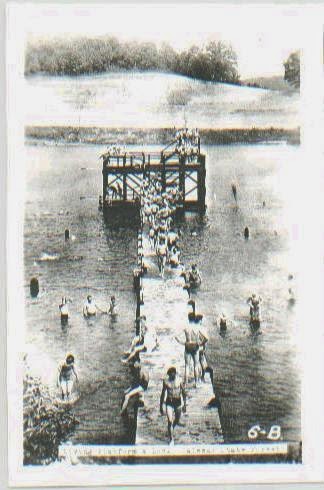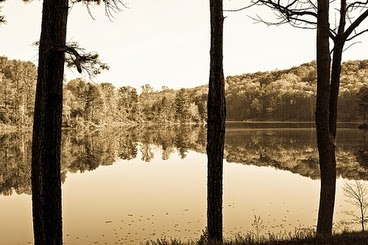Back in the 1930s when millions of people were out of work, most people thought that it was OK, even wonderful, that the federal government would step in and help to provide good jobs for people, especially since there was so much work that needed to be done. Much of that needed work was fixing what previous generations of people had broken through lack of foresight, no sense of wise land use, and even from simple greed. That certainly was true in the rural areas of Ohio where I grew up. Forests had been stripped, top-soil had eroded away, mine tailings dumped near water sources, and streams had been polluted. Many poor homesteads and small villages were left to decay. Work was scarce, the economy poor.
So F.D.R., the President that some people chose to hate, created the Works Progress Administration and the Civilian Conservation Corps. Just in our area alone, hundreds upon hundreds of people were given useful jobs during the 1930s. Thousands of trees were planted to prevent further soil erosion and pollution of waterways. Roads were improved, and small concrete bridges replaced fords through streams.
Nature had created no natural lakes in the area; so to help control water-flow and to boost the local economy in the Zaleski Forest region, a small damn was built, creating a many-fingered lake. Workers built a swimming area with wooden docks and diving towers. They made places for boating and canoeing. They added a picnic area with benches and fireplaces along side of the shore. They built a road to a scenic overlook where, eventually, a rustic lodge was constructed. Nearby, they made several wooden cabins for campers. The Division of Forestry officially opened the Zaleski Forest Park in 1940. Once the Division of Parks and Recreation was created 1949, it was renamed Lake Hope State Park. The area has provided employment and recreation ever since.
I recall with pleasure and a good amount of nostalgia visiting Lake Hope on many occasions from as young as age two. Sometimes it was just our family; at other times it was with family friends. During those first years, the three routes to the lake were gravel. The northern route was the shortest and passed by the remains of a stone structure resembling an oversize barbeque chimney. It was just one of several dozen 18th and 19th-century iron furnaces long abandoned since the charcoal and ore had been depleted in the area. The southern route took us through miles of hilly rural forest including many acres of pines planted by the C.C.C. And, the eastern route was the most primitive route of all, winding its way through the dense woods past abandoned and near-abandoned settlements and crossing the railroad tracks near the Moonville Tunnel, built in the mid-1800s. The tracks are long-gone, and the tunnel now is rumored to be haunted.
I recall how with excitement I would catch the first sight of the lake, eagerly looking forward to going to the man-made beach. We would wind our way to the parking lot and head for the wooden bathhouse. At age two, I was taken by my mother to the women’s side. (Yes, I can remember that young.) When older, my father took me to the men’s. When so young, I was required to stay near the beach, but I remember seeing my oldest brother going out to the wooden diving tower, climbing up so high, and diving in.
 |
| Vintage photo of Lake Hope’s swimming area |
My family and friends would bring along picnics, and afterwards we would find a picnic table near the water’s edge and lay out our food on one of the tables. Little stone fireplaces were provided in case we wished to grill hamburgers or hotdogs. We did not know in those days that potato chips were not so healthful, but we loved them and looked forward to our friends bringing them. They actually brought commercial-size bucketsful. Then there was desert.
Once sated with picnic-food, we would stroll along a path that closely followed the edge of the lake, listening for birds and watching for water foul. In the time of my childhood, the lake was surrounded by old-growth as well as reforested hills. Looking across the lake in any direction, I enjoyed seeing the wooded hills reflected, mirror-image, in the calm water.
 |
| Vintage photo of Lake Hope — a mirror image |
On other occasions, we rented a small cabin up near the lodge. They had few real amenities, but at least there was a roof over our heads. We brought food and supplies with us, and the lodge was nearby in case we needed anything more.
Later, when my grandmother once came visiting, we took her with us to Lake Hope. It was my birthday, and she thought that I was old enough by then for me to have a Camp King jackknife. My mother did not; she was sure that I would cut myself. Of course, I did, but it was only a slight wound on my thumb.
And as we grew older, we made use of the beautiful stone and wood lodge for dinner. It was perched high on the ridge and had a fine view through the trees to the shimmering lake below. Near the entrance to the dining room, they had placed a Skittles game, and we kids enjoyed playing it when we had some time after our meal. I was sorry to learn that the lodge burned to the ground in 2006. I new one has been built to replace it.
More than seventy years have passed since Lake Hope was opened to the public. Generations of families, locals, and students from surrounding colleges, have enjoyed the facilities and the beauty of this lake. When I last visited there, my memories flowed. Looking across the lake and admiring the mirror-image reflections from the wooded hills, I felt a twinge of nostalgia. I knew that generations more of employees and visitors would continue to enjoy this little Eden. Those 1930s politicians who opposed such projects, those hard-nosed naysayers, were proved wrong. Thank you, you far-sighted individuals who made possible the many benefits from their proposed work projects. Thank you W.P.A. and C.C.C. for work well done.
About the Author
I have had a life-long fascination with people and their life stories. I also realize that, although my own life has not brought me particular fame or fortune, I too have had some noteworthy experiences and, at times, unusual ones. Since I joined this Story Time group, I have derived pleasure and satisfaction participating in the group. I do put some thought and effort into my stories, and I hope that you find them interesting.
